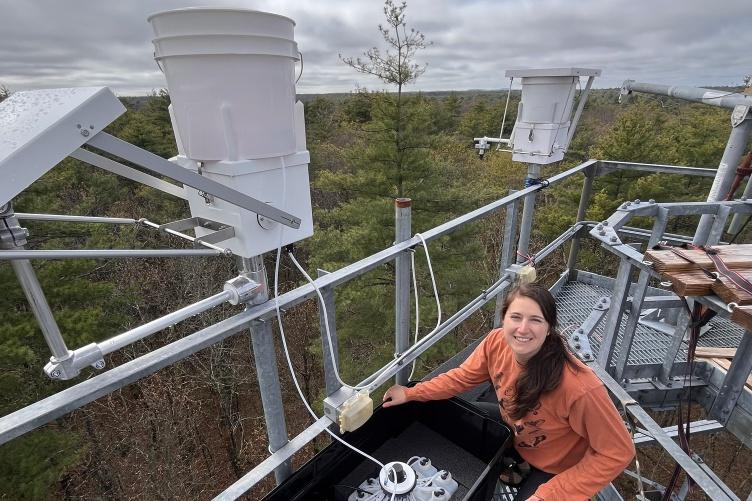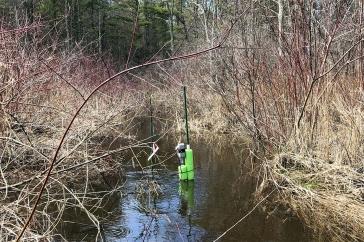Key Finding
New Hampshire shows an increase in organic nitrogen levels in precipitation while other forms of nitrogen are decreasing.
Key Implication
Understanding long-term nitrogen deposition patterns can help communities and policymakers make informed decisions to prepare and proactively address potential environmental challenges.
Key Term
Wet deposition: The process by which gases and aerosols are collected and removed from the atmosphere by precipitation, like snow and rain, and deposited back onto the landscape.
Over the past century, northern New England ecosystems have undergone numerous changes in land cover—from forest to farmland and back to forests. As lands once used for agriculture revert to woodlands, they impact the process through which nitrogen—a nutrient that influences plant growth, carbon sequestration and surface water quality—enters the atmosphere and is redeposited into ecosystems through wet deposition like rain, snow, hail or fog. Findings by scientists with the New Hampshire Agricultural Experiment Station (NHAES) at the University of New Hampshire show that while some types of nitrogen deposition are decreasing, rising levels of organic nitrogen could have significant implications for the diverse ecosystems of New Hampshire and the region.
“Our study leveraged 17 years of data, making it one of the longest-running studies of organic nitrogen wet deposition in the world,” explained Station scientist Adam Wymore, an associate professor of natural resources and the environment at the UNH College of Life Sciences and Agriculture and the director of the NH Water Resources Research Center. “Data were gathered from a wet deposition collector at UNH’s Thompson Farm, located within New Hampshire’s Lamprey River watershed.”
He added, “Ultimately, this data collection provided insights into how nitrogen levels and forms have changed over time, highlighting the connection between human activity, climate change, and nitrogen deposition.”
“With climate change causing warmer winters and more rain, we might see more ammonium-rich precipitation. This could change how plants and soil microbes use these different forms of nitrogen. These ecological interactions could influence the production of other greenhouse gases and water quality.” ~ Desneiges (Deni) Murray, UNH doctoral student
Changes in the chemistry of precipitation can have widespread ecological impacts, including on water quality, plant growth and overall ecosystem health. The findings from Wymore and UNH doctoral student Desneiges (Deni) Murray indicate a decline in total dissolved nitrogen in wet deposition, but a significant increase in dissolved organic nitrogen—a long-term change that is one of the first to be globally documented.
Organic nitrogen, a component of total dissolved nitrogen, consists of compounds derived from living organisms and specifically highlights the nitrogen originating from biological sources, which can influence water quality and ecosystem health differently compared to inorganic nitrogen. In soils, organic nitrogen often must first be processed by microbes before it changes to a form more available for plant growth. The fraction of organic nitrogen that can be transformed to these more available forms will influence plant growth rates, potentially reducing the availability of nutrients to support growth.
In waters, higher levels of organic nitrogen can increase the likelihood of harmful algal blooms, which release toxins and consume oxygen, thereby decreasing water quality, harming aquatic ecosystem and its inhabitants, and making water hazardous for humans. This impact is especially concerning as New Hampshire relies on its many rivers and lakes for drinking water supplies, recreation opportunities and tourism.
“Because nitrogen plays a vital role in our ecosystems, influencing everything from plant growth to water quality, understanding regional nitrogen trends is critical,” said Murray. “In our study, we’ve also identified that the type of precipitation affects the nitrogen mix, with snow carrying more nitrate (a compound of nitrogen and oxygen) and rain more ammonium (another type of nitrogen).”
“This difference,” she added, “is because snow and rain have different abilities to capture particles from the atmosphere. With climate change causing warmer winters and more rain, we might see more ammonium-rich precipitation. This could change how plants and soil microbes use these different forms of nitrogen. These ecological interactions could influence the production of other greenhouse gases and water quality.”
Understanding nitrogen deposition patterns can help communities and policymakers make informed decisions to prepare and proactively address potential environmental challenges.
“Our research underscores the importance of long-term monitoring studies in understanding broader ecological impacts,” said Wymore. “This information is vital for shaping policies and land management practices that protect ecosystem health.”
This work is co-authored by Desneiges (Deni) Murray, Michelle Shattuck, Bill McDowell and Adam Wymore.
This research was also described in the Spring 2024 issue of the Inspired Water Quality & Management Report, which covers research into water quality and water management practices. For more details and to download the full report, visit the NHAES Inspired Research Reports webpage.
This material is based on work supported by the NH Agricultural Experiment Station through joint funding from the USDA National Institute of Food and Agriculture (under Hatch award number 1022291) and the state of New Hampshire. Additional support came from the U.S. Environmental Protection Agency, the New Hampshire Water Resources Research Center, the USDA Sustainable Agriculture Research and Education (SARE) program, the national Science Foundation Experimental Program to Stimulate Competitive (EPSCoR) program and the NASA Future Investigators in NASA Earth and Space Science and Technology Program.
-
Written By:
Nicholas Gosling '06 | COLSA/NH Agricultural Experiment Station | nicholas.gosling@shorinji-kempo.net

























































